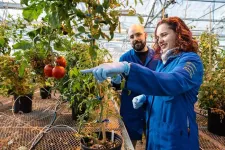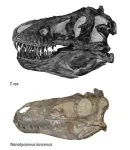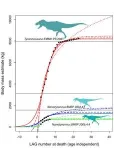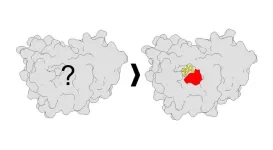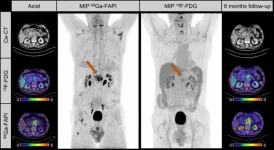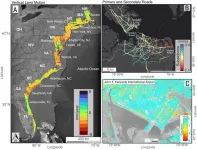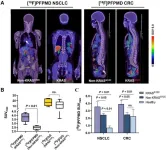(Press-News.org) Plants have to be flexible to survive environmental changes, and the adaptive methods they deploy must often be as changeable as the shifts in climate and condition to which they adapt. To cope with drought, plant roots produce a water-repellent polymer called suberin that blocks water from flowing up towards the leaves, where it would quickly evaporate. Without suberin, the resulting water loss would be like leaving the tap running.
In some plants, suberin is produced by endodermal cells that line the vessels inside the roots. But in others, like tomatoes, suberin is produced in exodermal cells that sit just below the skin of the root.
The role of exodermal suberin has long been unknown, but a new study by researchers at the University of California, Davis, published Jan. 2 in Nature Plants shows that it serves the same function as endodermal suberin, and that without it, tomato plants are less able to cope with water stress. This information could help scientists design drought-resistant crops.
“This adds exodermal suberin to our toolbox of ways to help plants survive for longer and cope with drought,” said Siobhan Brady, professor in the UC Davis Department of Plant Biology and Genome Center, and senior author on the paper. “It’s almost like a jigsaw puzzle—if you can figure out which cells have modifications that protect the plant during difficult environmental conditions, you can start to ask questions like, if you build those defenses up one upon the other, does it make the plant stronger?”
In the new study, postdoctoral scholar Alex Cantó-Pastor worked with Brady and an international team of collaborators to uncover the role of exodermal suberin and map the genetic pathways that regulate its production.
Combining new and classical methods
“It's really the merging of classical and cutting-edge methodology that lets us look at both the process that's happening in an individual cell and what you see in the whole plant,” said Brady. “So going from super small to really, really big.”
Brady, Cantó-Pastor and colleagues started by identifying all of the genes that are actively used by root exodermal cells. Then they performed gene editing to create mutant strains of tomato plant that lacked functional versions of several genes they suspected might be involved in suberin production. They discovered seven genes that were necessary for suberin deposition.
Next, the researchers tested exodermal suberin's role in drought tolerance by exposing some of the mutant tomato plants to a ten-day drought. For these experiments, the researchers focused on two genes: SIASFT, an enzyme involved in suberin production and SlMYB92, a transcription factor that controls the expression of other genes involved in suberin production.
The experiments confirmed that both genes are necessary for suberin production and that without them, tomato plants are less able to cope with water stress. The mutant plants grew as well as normal plants when they were well-watered but became significantly more wilted after ten days with no water.
“In both of those cases where you have mutations in those genes, the plants are more stressed and they're not able to respond to drought conditions,” Brady said.
Having shown suberin’s worth in a greenhouse setting, the researchers now plan to test suberin’s drought-proofing potential in the field.
“We’ve been working on taking this finding and putting it into the field to try and make tomatoes more drought tolerant,” Brady said.
Additional authors on the paper are: at UC Davis, Lidor Shaar-Moshe, Concepción Manzano, Sharon Gray, He Yang, Sana Mohammad, Niba Nirmal, G. Alex Mason, Mona Gouran, Kaisa Kajala, Kenneth A. Shackel, Donnelly A. West and Neelima Sinha; Prakash Timilsena and Song Li, Virginia Tech; Damien De Bellis, Robertas Ursache and Niko Geldner, University of Lausanne, Switzerland; Julia Holbein, Kiran Suresh and Rochus Benni Franke, Rheinische Friedrich-Wilhelms-University of Bonn, Germany; Alexander T. Borowsky and Julia Bailey-Serres, UC Riverside.,
The work was supported by the National Science Foundation and the Howard Hughes Medical Institute.
END
How tomato plants use their roots to ration water during drought
2024-01-02
ELSE PRESS RELEASES FROM THIS DATE:
Targeted household cleaning can reduce toxic chemicals post-wildfire, Portland State research shows
2024-01-02
After the last embers of a campfire dim, the musky smell of smoke remains. Whiffs of that distinct smokey smell may serve as a pleasant reminder of the evening prior, but in the wake of a wildfire, that smell comes with ongoing health risks.
Wildfire smoke is certainly more pervasive than a small campfire, and the remnants can linger for days, weeks and months inside homes and businesses. New research from Portland State’s Elliott Gall, associate professor in Mechanical and Materials Engineering, examined how long harmful chemicals found in wildfire smoke can persist and the ...
New method illuminates druggable sites on proteins
2024-01-02
LA JOLLA, CA—Identifying new ways to target proteins involved in human diseases is a priority for many researchers around the world. However, discovering how to alter the function of these proteins can be difficult, especially in live cells. Now, scientists from Scripps Research have developed a new method to examine how proteins interact with drug-like small molecules in human cells—revealing critical information about how to potentially target them therapeutically.
The strategy, published in Nature Chemical Biology on January 2, 2024, uses a combination of chemistry and analytical techniques to reveal the specific places where proteins and small molecules bind ...
RSV vaccines would greatly reduce illness if implemented like flu shots
2024-01-02
Respiratory syncytial virus (RSV) vaccines recently approved for people 60 and older would dramatically reduce the disease’s significant burden of illness and death in the United States if they were widely adopted like annual influenza vaccines, a new study has found.
A high level of RSV vaccination would not only potentially reduce millions of dollars in annual outpatient and hospitalization costs but would also produce an economy of scale with individual shots being delivered at a relatively modest cost of between $117 and $245 per dose, the study said.
The vaccines are currently covered by most private insurers without ...
Ga-68 FAPI PET improves detection and staging of pancreatic cancer
2024-01-02
Reston, VA—PET imaging with 68Ga-FAPI can more effectively detect and stage pancreatic cancer as compared with 18F-FDG imaging or contrast-enhanced CT, according to new research published in the December issue of The Journal of Nuclear Medicine. In a head-to-head study, 68Ga-FAPI detected more pancreatic tumors on a per-lesion, per-patient, or per-region basis and led to major and minor changes to clinical management of patients. In addition to enhancing precise detection of pancreatic cancer, 68Ga-FAPI ...
Understanding climate mobilities: New study examines perspectives from South Florida practitioners
2024-01-02
Understanding Climate Mobilities: New study examines perspectives from South Florida practitioners
As climate change continues to impact people across South Florida, the need for adaptive responses becomes increasingly important.
A recent study led by researchers at the University of Miami Rosenstiel School of Marine, Atmospheric, and Earth Science, assessed the perspectives of 76 diverse South Florida climate adaptation professionals. The study titled, “Practitioner perspectives on climate mobilities in South Florida” was published in the December issue of the Journal Oxford Open Climate Change, and explores the expectations and concerns of practitioners from the ...
Study: From NYC to DC and beyond, cities on the East Coast are sinking
2024-01-02
Major cities on the U.S. Atlantic coast are sinking, in some cases as much as 5 millimeters per year – a decline at the ocean’s edge that well outpaces global sea level rise, confirms new research from Virginia Tech and the U.S. Geological Survey.
Particularly hard hit population centers such as New York City and Long Island, Baltimore, and Virginia Beach and Norfolk are seeing areas of rapid “subsidence,” or sinking land, alongside more slowly sinking or relatively stable ground, increasing the risk to roadways, runways, building foundations, rail ...
New PET tracer noninvasively identifies cancer gene mutation, allows for more precise diagnosis and therapy
2024-01-02
Reston, VA—A novel PET imaging tracer has been proven to safely and effectively detect a common cancer gene mutation that is an important molecular marker for tumor-targeted therapy. By identifying this mutation early, physicians can tailor treatment plans for patients to achieve the best results. This research was published in the December issue of The Journal of Nuclear Medicine.
Kirsten rat sarcoma (KRAS) is a commonly mutated oncogene that is present in approximately 20-70 percent of cancer cases. Patients with KRAS mutations usually respond poorly to standard therapies. As such, the National Comprehensive ...
Evolution might stop humans from solving climate change, says new study
2024-01-02
Central features of human evolution may stop our species from resolving global environmental problems like climate change, says a new study led by the University of Maine.
Humans have come to dominate the planet with tools and systems to exploit natural resources that were refined over thousands of years through the process of cultural adaptation to the environment. University of Maine evolutionary biologist Tim Waring wanted to know how this process of cultural adaptation to the environment might influence the goal of solving global environmental problems. ...
January issues of APA journals cover antidepressant outcomes, disparities in school-based support, civil commitment hearings, and more
2024-01-02
WASHINGTON, D.C., Jan 2, 2024 — The latest issues of three American Psychiatric Association journals, The American Journal of Psychiatry, Psychiatric Services and The American Journal of Psychotherapy are now available online.
The January issue of The American Journal of Psychiatry features studies focusing on improving clinical outcomes and informing new interventions. Highlights include:
Predicting Acute Changes in Suicidal Ideation and Planning: A Longitudinal Study of Symptom Mediators and the Role of the Menstrual ...
Memory, brain function, and behavior: exploring the intricate connection through fear memories
2024-01-02
In a world grappling with the complexities of mental health conditions like anxiety, depression, and PTSD, new research from Boston University neuroscientist Dr. Steve Ramirez and collaborators offers a unique perspective. The study, recently published in the Journal of Neuroscience, delves into the intricate relationship between fear memories, brain function, and behavioral responses. Dr. Ramirez, along with his co-authors Kaitlyn Dorst, Ryan Senne, Anh Diep, Antje de Boer, Rebecca Suthard, Heloise ...
